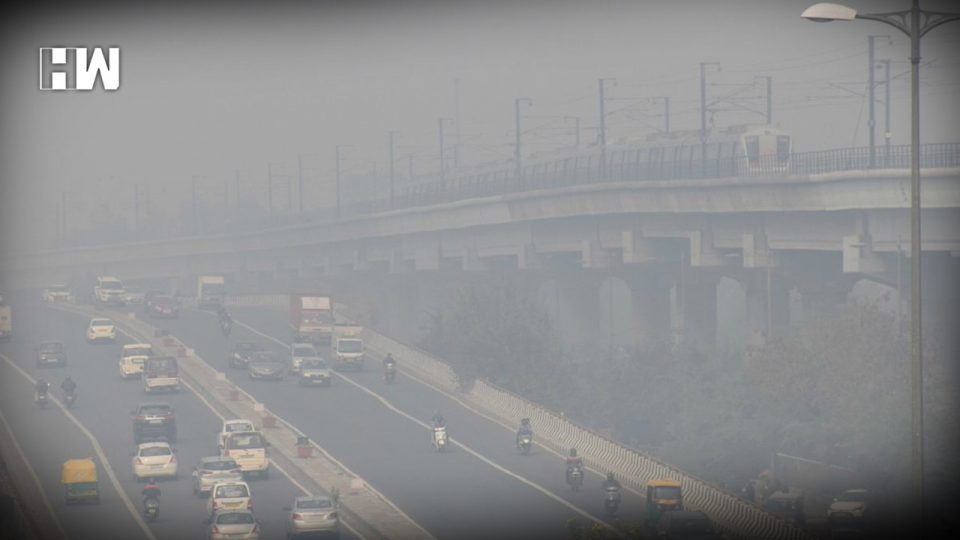The Ministry of Earth Sciences’ air quality monitor, SAFAR, said the Delhi overall AQI reached as high as 708 around 5 pm, which is 14 times the safe level of 0-50.
New Delhi: Delhi and its surrounding areas were enveloped in heavy, toxic smog on Sunday as pollution levels peaked to a three-year high, prompting hundreds of distraught people to say they wanted to leave the city due to poor air quality.
On Sunday according to the Central Pollution Control Board (CPCB), the national capital’s 24-hour average air quality index (AQI) stood at 494 at 4 pm, the highest since November 6, 2016, when it was 497
The AQI recorded Twenty-one of the 37 air quality monitoring stations between 490 and 500 with air quality sensors at Aya Nagar, Ashok Vihar, Anand Vihar, and Aurobindo Marg peaked out at 7 pm.
A blanket of haze engulfing Delhi. No respite from the severe level of pollution. Children, elderly & labourers are worst hit. Hope tomorrow is better! #DelhiAirEmergency pic.twitter.com/CmGj07ZgBl
— Usha Padhee (@ushapadhee1996) November 3, 2019
In Delhi (NCR), Faridabad with AQI 493, Noida (494), Ghaziabad (499) and Greater Noida (488), Gurugram (479), also considered extremely polluted air.
The Ministry of Earth Sciences’ air quality monitor, SAFAR, said the Delhi overall AQI reached as high as 708 around 5 pm, which is 14 times the safe level of 0-50. An AQI between 0-50 is considered ‘good’, 51-100 ‘satisfactory’, 101-200 ‘moderate’, 201-300 ‘poor’, 301-400 ‘very poor’ and 401-500 ‘severe’. An AQI above 500 falls in the ‘severe plus’ category.
07:00 am (4th Nov 2019)
The poisonous smog has slowly covered much of South India.
West Bengal and Bihar has turned into deep red. Delhi looks like a war zone. Even Nepal, Bhutan and Bangladesh have bad Air Quality now. #Chernobyl pic.twitter.com/6LMNVyvfps
— Advaid (@Advaidism) November 4, 2019
The apocalyptic haze stiffened its choke on Delhi and satellite towns as scattered rains on Saturday increased humidity, leading to smog and a cloud cover preventing sun rays from warming the ground. Due to smog low visibility at the Delhi airport led to the diversion of 37 flights to other airports.
Till November 5 the spurts in pollution levels also prompted the administrations in Ghaziabad, Noida, Greater Noida, Gurgaon and Faridabad to shut all government and private schools. On Friday the Delhi government directed the closure of schools till November 5.
Noida is a satellite city to Delhi. Nearly 2000 AQI! That’s like smoking 3 packs of cigarettes a day. #DelhiAirEmergency https://t.co/Tca0qKcmn9
— Siobhan Heanue (@siobhanheanue) November 3, 2019
“On Sunday Wind speed increased significantly. But the smog, due to high humidity after scattered rains, and a cloud cover didn’t let sun rays reach the ground. As a result, the air near the ground remained cold and heavy,” Mahesh Palawat, a senior scientist at Skymet Weather, a private forecaster, explained.
NASA satellite imagery showed vast swathes of the northern plains, covering Punjab, Haryana, Delhi, Uttar Pradesh, Bihar, and parts of Jharkhand and West Bengal, blanketed under a smoky haze.
If any significant improvement in the situation is highly unlikely unless they’re a rainfall, which may on November 7 and 8 under the influence of Cyclone Maha and a western disturbance, washes away the pollutants said the weather expert.
Meanwhile, Delhi Chief Minister Arvind Kejriwal questioned the pace at which the Centre was distributing machines among farmers for in-situ management of straw to prevent stubble burning.
The Delhi CM “Till now 63,000 machines have been made available to farmers in Punjab and Haryana. There are 27 lakh farmers in these states. How long would it take to distribute machines to all these farmers? For how long do we have to bear this pollution,”.
As an independent media platform, we do not take advertisements from governments and corporate houses. It is you, our readers, who have supported us on our journey to do honest and unbiased journalism. Please contribute, so that we can continue to do the same in future.

